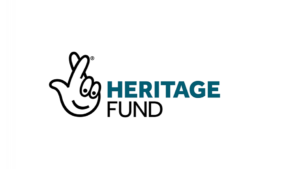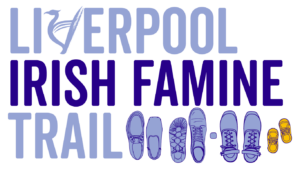In 2021 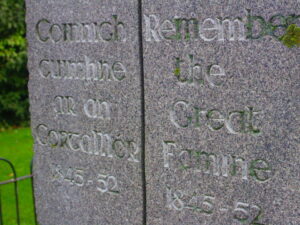 Liverpool Irish Festival secured funding from the National Lottery Heritage Fund to begin work on regenerating the Liverpool Irish Famine Trail.
Liverpool Irish Festival secured funding from the National Lottery Heritage Fund to begin work on regenerating the Liverpool Irish Famine Trail.
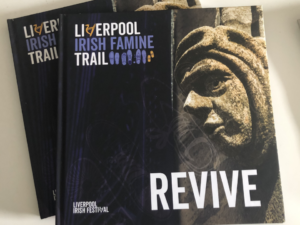 Since winning our first fund, we have
Since winning our first fund, we have
- written a book (left; available to buy in hardback)
- developed an ePublication, here
- designed and will soon release a presentation map, for sale
- designed and released a print-at-home map
- created and shared an interactive, enhanced Google map
- secured further funding, totalling almost £150k in 3-years
- begun a partnership with Strokestown Estate and National Famien Way, connecting our two Trails.
In 2023, we secured a second scheme of funding from The National Lottery Heritage Fund to expand our work, produce another book, run community projects, develop more guides and start to develop an app. You can see a bit more on that, here.
We’ve also developed a large scale pilgrimage project, leading from Strokestown (Co. Roscommon, Ireland) to Liverpool. Read about our Strokestown Bronze Shoe walk and other things that are happening as of March 2024, using this link.
Maps
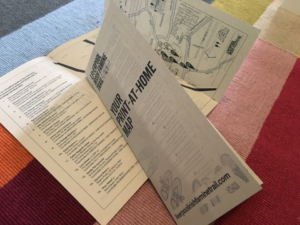 Left: our tri-fold, print-at-home map gives short details to all our Trail sites and links to our enhanced Google map, so it’s a useful thing to keep in your top pocket! This black-and-white version is low on inks, helping to save the planet!
Left: our tri-fold, print-at-home map gives short details to all our Trail sites and links to our enhanced Google map, so it’s a useful thing to keep in your top pocket! This black-and-white version is low on inks, helping to save the planet!
We are developing community activities and a series of assets to populate a significant digital app, that we hope to make available in future years. Such development takes time and resources. We are doing all we can to move these forward. An enhanced Google map of the Trail is now available, too. More of what we aim to achive can be found below.
Before we give many more details, we would like to thank the National Lottery Heritage Fund (and players of the Lottery) for their interest, support and trust in us. We would also like to thank Greg Quiery and the Great Hunger Commemoration Committee, for their work with us on this. We will forever be indebted to them and the services they developed in the 1990s and for their onward generosity to the project.
The project
The Liverpool Irish Famine Trail was originally researched and built by Liverpool’s Great Hunger Commemoration Committee in the late 1990s. Like many things from the late 90s, some of the Liverpool Irish Famine Trail sites have seen better days. Given the advances we have made in the last 25+ years -including internet connectivity, accessibility recognition and mapping systems- it is fair to say the Trail will benefit from a refresh. Our intention is to provide much more information about the sites and allow users to walk specific trails and access relevant information using digital technologies.
In many ways, despite how much we have already researched and produced, we are still in the early days of the project’s development, awaiting funding decisions that will enable us to proceed at pace. That said, we have now got a living archive, are building stories to share and have an exceptional History Resarch Group, who continue their work finding out more about the Trail sites; the impact of the Irish Famine on Liverpool and the affects An Gorta Mór had on the wider region. As the project progresses, we’ll share information and resources providing access to the Trail, which has long been out of service.
Here’s a link to the original 1997 leaflet, which we will regenerate with community group assistance, soon.
We have also developed an enhanced Google map, which can be used on your desktop or mobile device, so you can learn about each of the different sites, see related personal stories and view a gallery of images. Access that map here.
Initial plans
The Great Hunger, or An Gorta Mór, changed the shape of Britain’s society, particularly here in England’s North West. The existing ‘Trail’ is an unrealised asset in Liverpool’s cultural offer and a missing link in the search many Irish diaspora people undertake to trace their families. Our initial project plans will
- resurrect the 1990s work of the Liverpool Great Hunger Commemoration Committee
- establish custodianship of the relevant sites
- lay down technical frameworks for future community projects, including digital infrastructure and recommendations as well as creating points of contact for future projects
- site test and condition report existing plaques as well as making recommendations for future site markings, in accordance with greater access, digital integrations and modern capability
- formalise links with international sites, such as Strokestown Park Museum and National Famine Way (Ireland) and Quinnipiac (Canada)
- create community networks, begin public awareness raising, funding campaigns and research groups
- develop a self-guided walking programme for the trail, as well as a water tour, partnering with Sovino group and the Pride of Sefton
- build resilience for the custodian organisation, also stabilising the legacy of the Trail.
Building a case for support (March 2021)
Timely
2020 marked 175 years since the beginning of the 7 year stretch that was An Gorta Mor Although primed to submit a Heritage application last year, C-19 prevented us, by days, after 8 months of preparation. The anniversaries are passing and the existing plaques are failing. One is already lost to time.
Members of the Great Hunger Commemoration Committee have already passed on. Before we lose any more -and whilst we have access to one of its pioneer members- we are keen to get working and break ground. We currently hold the IP for the idea and have the blessing of the Committee, but if we falter much longer, others may outpace us to create a commercial venture, rather than a societal one, which truly considers deep heritage and cultural approaches. As a team, we believe this will miss considerable opportunities to build community projects, document personal stories and involve the people at the heart of this history in its development.
One plaque has been lost and it is clear custodians have moved on. It is imperative that a meaningful, well considered and long-term plan is developed to secure the sites, share the history and maintain the heritage for audiences now and in to the future.
Demand
There is a known desire to see the Trail up and running; we know community groups, institutions and cultural organisations who are keen to use it now. Under Covid conditions, we -in partnership with the Great Famine Voices Roadshow and the Institute of Irish Studies– were able to engage 2418 people in online sessions about the Famine in May 2020. Since then, a further 6,007 people have watched those sessions. In Oct 2021, we premiered a new film of individual stories about Irish migration, which reached 1.6k on social media and has been viewed almost 500 times.
Changing perceptions and understanding
Famine awareness has altered; revisionist history is revealing new truths/perspectives that warrant investigation, appreciation and recognition. Migration also has changing connotations, which must be reappraised to consider emotional wellbeing, identity, compassion and community cohesion. Indeed, hunger and public health are topics more relevant now than ever since WWII, making now an ideal time to raise this project.
This trail’s 7 plaques and (min) 8 sites are linked by little but a few people’s remaining knowledge, despite its deep significance to the city’s history and heritage. It needs recognition, particularly for those tracing their genealogy or tourists (local, national and international) connecting with Liverpool’s life.
Having secured two rounds of funding, we believe there’s a minimum of 5-years more work required to grow this historic and significant concert in to a tour de force.
Cultural asset and organisational stability
The Festival originated this idea in 2019 and believes the regeneration of the Trail will not only build a ‘new’ asset for the city, but that it will stabilise the Festival’s core work by providing a year-round asset for people to invest in. That said, Liverpool Irish Festival‘s heritage capacity, without specific support, is limited. It took six applications to secure the two rounds of funding, which is a lot of work for a micro organisation.
Our expansion plans build capacity and this project forms a significant part of that, contributing to roles and developing programme that will feature within the Festival (annually). Covid-19 proved we were right to push long-term aspirations; pushing us to secure our heritage.
The intentions
- A working, accessible trail, with online support
- A detailed recommendation for the next steps and stages, outlined in our business plan, including digital plan, site restoration/marking recommendations
- Increased awareness of the trail and a concept to link and hang community generated projects on^.
Citizen projects
The Trail work will be owned by the Festival and will acknowledge all support received throughout its life. The plan is to use the foundation built in Stage 1 to grow citizen projects to improve at-site access to information, identified by an app and a website, with AI or AR technology. We expect to develop films, signs, artworks, songs and more, that people can access whilst on the trail or from international locations.
If they are willing, there will always be more research for our research groups to undertake and bandwidth on our website for additions to be made. We hope to create a long-term network for them and a space in which they can develop their learning, share stories and grow our understanding of the migrations, influence and impact that make up the An Gorta Mór story.
Custodians
We will maintain year-round contact with specific site custodians and link events to the Trail every Festival, telling stories and sharing information found and projects undertaken across the year.
All our work will be documented and shared online and we will produce trail maps, excursion day ideas and fact sheets about the different sites. Our information will be shared with the Council and other tourism operators, as well as cultural networks we are part of so others can cheerlead, too.
We will use the success of this project to leverage sponsorships and private investment to progress work, as well as make a brief to create a Trail specific app, with web integration if possible. This work needs resourcing and the R&S for this will take place in this project.
Future work
^Future work we anticipate includes
- assigning located custodians to report or act on plaque decay
- expand the history groups researcher’s work and numbers
- raising funds for reconditioned/new plaques (materials to be weather ready and designed to last (e.g., bronze or something similar))
- linking events and audits to our annual festival in October
- website/app maintenance, keeping it secure and controlled. It will be linked to active sites such as Trip Advisor and Wikipedia to ensure it is usable and accessible from non-festival media. We will build in KPIs for this sub-site so that it is monitored year-on-year.
Long term
Our long-term plan develops rich content and art work for each of the sites (stages 2 and 3). We will then celebrate wider connections by taking the message of this project further afield – i.e., partnering with international famine trails such as those in Ireland and North America; making Eamonn O’Doherty Famine Memorial (sculptor) linkages; creating specific site linkages with departure points on the island of Ireland and international sister walks.
Evaluation
The project self-evaluates, ending in a series of recommendations. As the project grows, participants will evaluate their engagement, evidencing long-term impacts/outcomes of the project and catalysing the next stage. Trail and digital usage will be monitored year-on-year, alongside people’s online responses to their experience and testimonials.
Interested in getting involved?
Contact Emma Smith on [email protected]
